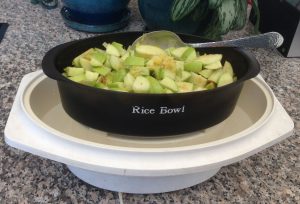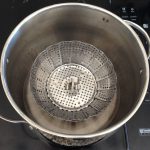Earlier this year I found this book of articles from the old Cayce newsletters (originally published in the 1970’s):
I was drawn to a chapter about Mr. Cayce’s advice for foods. In reading (462-14) (M 57, 1942), Cayce was asked about frozen foods, “especially [frozen] vegetables and fruits that are on the market today.” His answer was that it depends, but generally frozen fruits retain more of their vitamins than frozen vegetables. Cayce was also asked about “steam pressure for cooking foods quickly”. The response was that this cooking method “rather preserves than destroys” vitamins in fruits and vegetables.
Reading (243-36) (F 62, 1942) recommended cooking Jerusalem Artichokes in patapar paper “so that all the juice of same may be stirred or mixed with the bulk when this is eaten.” This food was to help with kidney inflammation.
Reading (133-4) gives more detailed instructions for cooking with patapar paper to extract the juice from vegetables:
6. Noons – not too much should be taken at this meal, and that only of vegetable juices. And the preferable way to prepare such juices would be through cooking the vegetables after tying them in Patapar paper; not putting them in water to boil, but cooking either in the Patapar paper or in a steam steamer, so that only the juices from the vegetables may be obtained – and no water added in the cooking at all. Then these juices should be combined and seasoned to the taste. This activity will build into the system the proper associations with that which has been indicated by the corrections in the spine, and make for the corrections in the activities throughout the digestive system.
(133-4), F-54, July 28th, 1934 (emphasis added)
I’d previously seen references to Patapar paper, but never thought to look for it. This reading notes that steamers are acceptable too. “Seasoned to taste” certainly refers to the adding of salt. The amount of salt needed varies from person to person and season to season – one’s own taste buds are the best indicator of the amount of salt necessary.
When I went to look at the full text of 133-4, I noticed that Gladys Davis provided this footnote:
[The Patapar paper for cooking the foods should be obtained at any ten cent store or department store, or the like. It is made by the Paterson Parchment Paper Co., Bristol, Penna. I am enclosing a sample for your use. Prepare the vegetables or any other foods for cooking…that is, clean and cut in small pieces…and tie up in the paper, using a stout white cord. Put in Boiler of water (not letting water get inside of paper) and boil from thirty-five to forty-five minutes, depending on what is being cooked. The paper may be washed…just as a cloth…and used again and again. GD.]
The Paterson Parchment Paper Co. is still in business, and they still sell the Patapar paper that Mr. Cayce recommends.
The ‘official supplier’ sells small quantities of Patapar paper:
Modern electric steamers are just as good as the old Patapar paper, and are infinitely more convenient. I found this rice/vegetable steamer at a garage sale for $3, and recently saw an identical unit at a thrift store for $7:
This steamer also has a slotted basket for cooking vegetables. But when this is used, the vegetables juices are entirely wasted. Cooking vegetables using the rice bowl allows all the fruit and vegetable juices to be saved.
This is, essentially, a double-boiler. One of these inexpensive double-boilers would probably work well enough with one of the pots you already have:
Some of the vegetables I steam regularly include green beans, okra, zuchini, and tomatoes. One of my family complains when I steam tomatoes, but Mr. Cayce said cooked tomatoes allows more of the nutrients to be absorbed.
This is a friend’s steamer basket. He tries to eat healthy, but uses too much water when cooking his zucchini. Any kind of vegetable is better than no vegetables, but he’d get more of the alkalizing minerals by using a small amount of water, and consuming the cooking water too.





